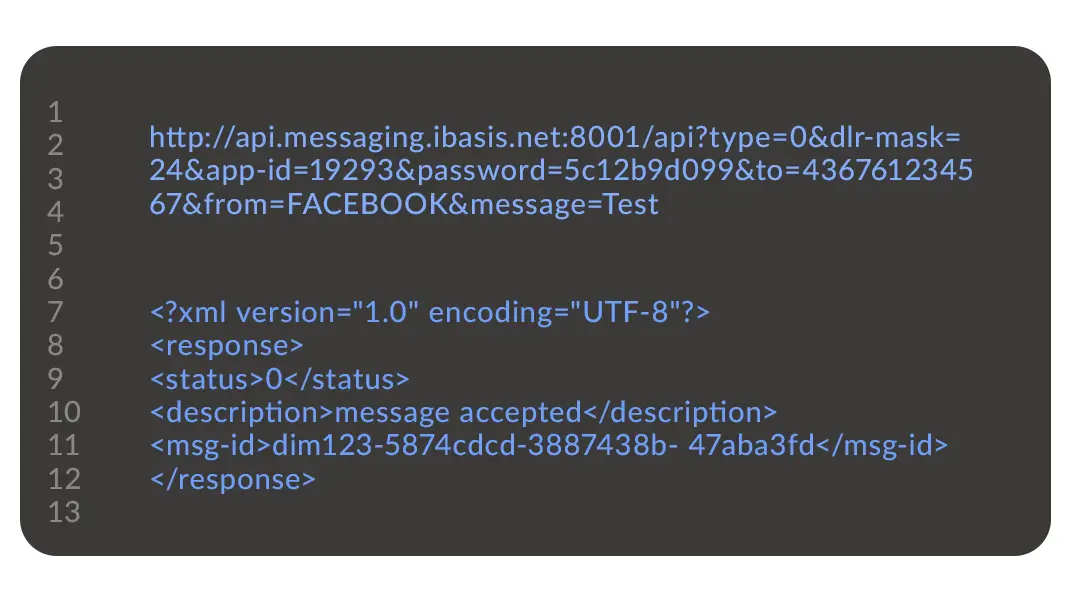MESSAGING API
Secure, Scalable & Flexible Messaging with the iBASIS Messaging API
The iBASIS Messaging API empowers businesses to send and receive SMS and RCS messages globally using robust HTTP and SMPP interfaces. It’s built for reliability, security, and flexibility—ideal for transactional alerts, OTPs, marketing campaigns, and two‑way communication across 190+ countries and 1,000+ operators.
The iBASIS SMS Gateway is seamlessly integrated with our APIs and provides a high-performance and carrier-grade messaging platform.


What is a Messaging API?
An API (Application Programming Interface) is a software interface that enables applications and systems to send and receive RCS & SMS messages through a telecom provider’s network. It allows businesses to integrate messaging functionality into their platforms—such as websites, CRMs, or mobile apps—using simple HTTP, SMPP, or REST-based connections.
The iBASIS Messaging API replaces our former SMS API and also functions as an RCS API, enabling seamless and flexible integration of multiple business communication channels.
API as an Advantage: Cost‑Effective, Real‑Time Communication at Scale
In the context of A2P messaging, APIs enable businesses to connect their systems with an aggregator’s platform to send and receive messages programmatically.
By leveraging an API, companies can achieve cost-effective, real-time communication at scale, delivering a direct and personalized way to engage customers through notifications, alerts, verifications, marketing campaigns, and more.

Key Features of the iBASIS SMS & RCS API
Bulk Messaging and Enterprise‑Grade Throughput
Supports high-volume message delivery with smart throttling for optimal performance
Global Delivery
Full access to tier‑1 operator networks; protocols supported: HTTP GET & POST, SMPP v3.4 (preferred TRX mode)
Two‑way Messaging
Receive inbound (MO) messages for interactive communication
CRM Integration
Personalized integration with third-party systems such as Salesforce or Oracle
Delivery Insights
Real‑time and handset-level reports, support for delivery reports (DLRs)
Security Features
Advanced protection through TLS / SSL encryption, VPN / IPSec, and IP, senders and countries whitelisting
Reach customers faster, boost engagement, and drive sales. Learn more about our SMS and RCS solutions.
We offer a 14-day free SMS API trial with full access and no commitment.
Pricing and Onboarding for the iBASIS Messaging API
How Our Onboarding and Launch Process Works
Account and Sender ID setup (at least 48 hrs)
IP whitelisting and credentials
API/SMPP connectivity tests
Compliance and operator regristration
Go live and monitoring setup
For transparent pricing and flexible options that fit your needs, contact your iBASIS Account Manager.
FAQ
1. How do you integrate a Messaging API?
After selecting an API provider, you’ll receive your API credentials and connection guide. You then configure the integration (via SMPP or HTTP), set up the handling of inbound and outbound messages, and perform testing to ensure everything functions as expected.
2. What if the SMS or RCS is not delivered?
Mobile Operators usually provide status codes and error logs troubleshoot delivery failures. Most messaging systems also implement retry mechanisms and fallback options to maximize delivery success.
3. Can I use the iBASIS Messaging API to send RCS messages?
Yes. The iBASIS Messaging API supports both SMS and RCS delivery using the same integration framework (HTTP or SMPP). Businesses can start with SMS and seamlessly expand to RCS when supported by their customers’ devices and operators, without needing separate integrations.
4. What happens if a recipient doesn’t support RCS?
If RCS is not available on the recipient’s device or network, messages can automatically fall back to SMS, ensuring full reach and consistent delivery, a key advantage of the iBASIS RCS/SMS hybrid solution.
5. What protocol does RCS use?
RCS (Rich Communication Services) is based on the SIP (Session Initiation Protocol) standard, the same protocol used for VoLTE and other IP-based communication services.
It operates over IP networks rather than traditional SMSC routes, enabling real-time data exchange for advanced features such as typing indicators, read receipts, media sharing, and suggested actions.
RCS also relies on Universal Profile (UP) specifications defined by the GSMA, which ensure interoperability between operators, devices, and messaging platforms worldwide.
6. What information do RCS Delivery Receipts (DLRs) provide?
RCS Delivery Receipts (DLRs) offer detailed, real-time feedback about message status — going beyond the basic “delivered” or “failed” reports used in SMS.
They can include:
- Message delivered: confirmation that the message has reached the recipient’s device.
- Message displayed (read): confirmation that the recipient has opened or viewed the message.
- Message failed: delivery errors or network issues.
- Fallback triggered: indicates that the message was sent as SMS when RCS was unavailable.
This richer reporting helps businesses measure engagement, optimize campaign performance, and monitor delivery quality more accurately than with traditional SMS DLRs.